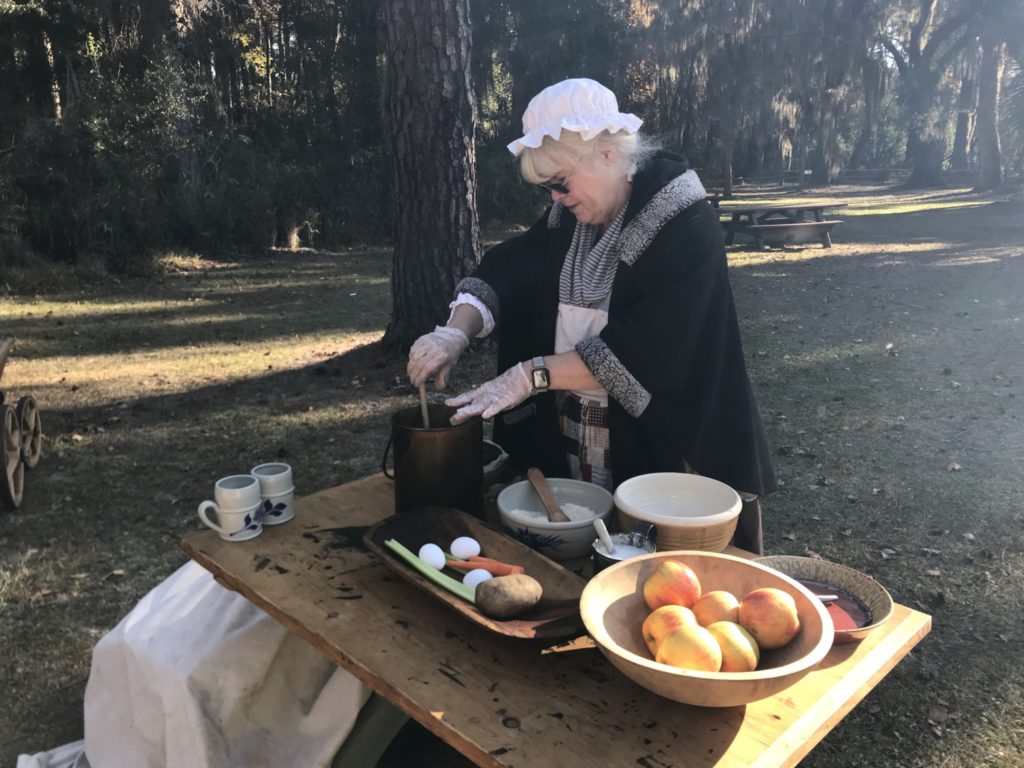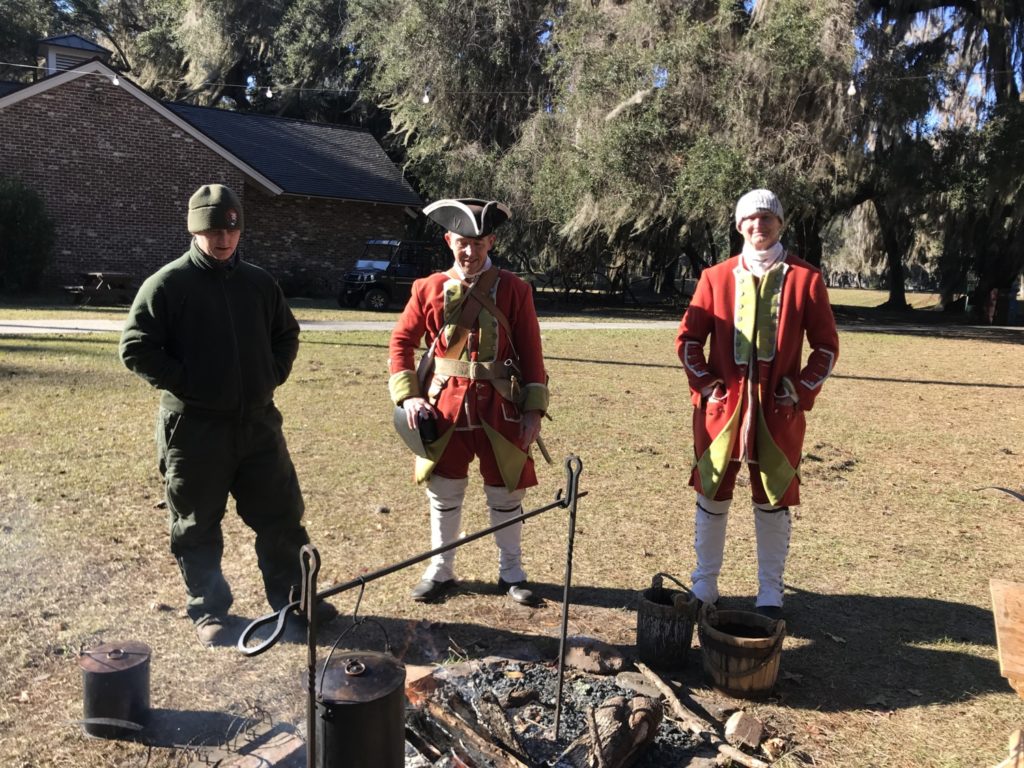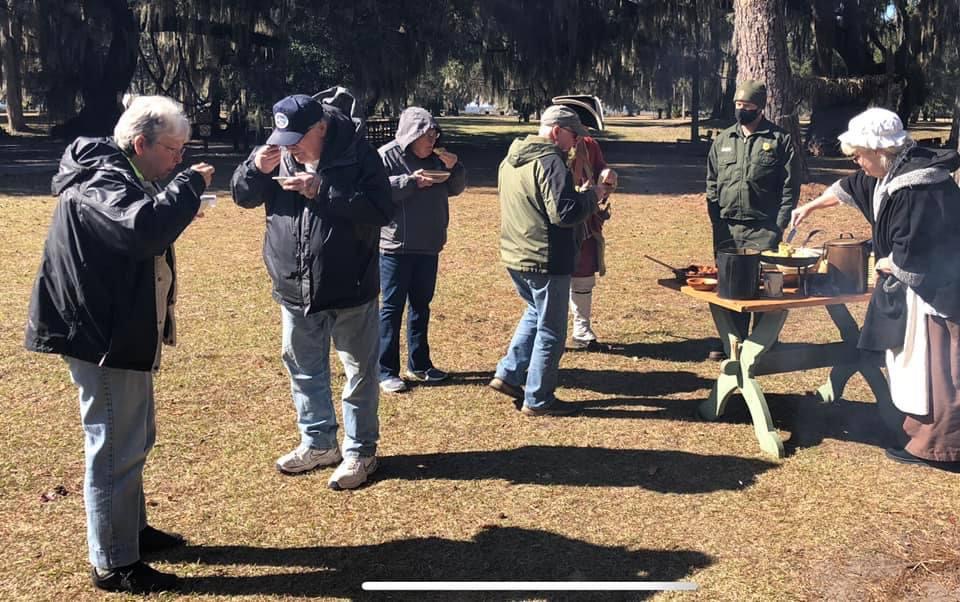One of the reasons we come to Georgia in the winter is for the lovely, warm weather. But we had some cold weekends in January. I know, compared to Ohio, the weather wasn’t really cold at all. Ohio has had a frigid January and we are not complaining about the relatively warm weather in Georgia.
On weekends, even if they are cold weekends, we are outside doing living history. Saturday, January 22, was a new level of cold for me while doing living history. It was cloudy and windy and the morning temperature was close to 32. I was cooking and I needed to chop up an onion and a potato for my Brunswick stew. But my hands were so cold I couldn’t hold the knife. Susan Jennings, my partner in cooking, graciously chopped up the vegetables.

I was also going to cook a pork roast on the rotisserie over the fire. Because of the wind and cold, it took too long to get the fire where we needed it to be and I had to save the roast for another day. The coals I use for the baking kettle cooled off so quickly that I had to keep piling more on. The rolls ended up burned on the top. Fortunately the stew turned out fine.

Usually all the volunteers come over for lunch, even if they aren’t working that day. It was so cold that four of the volunteers stayed in their RVs instead of coming outside for lunch. I was really glad to do the dishes on that Saturday because it was the only time my hands were warm. As soon as I finished cooking and washing the dishes, I headed inside. I demonstrate spinning and weaving and I can’t do either of them if I can’t move my hands. I set up my spinning wheel in the corner of the Museum and spent the rest of the afternoon warm.

Sunday, January 23, Tom and I dressed up in our historical outfits but I stayed inside all day. Steve and Susan Jennings just wore their volunteer clothes and worked at the desk. I set up my loom in the corner and demonstrated to anyone who came in. Tom spent most of his time in the breezeway greeting visitors. Despite the many layers of his British uniform, he was cold by the end of the day.

I was pretty cheerful about the cold. We usually have one, and only one, cold weekend every year. I was sure that January 22 and 23 would be the end of the cold.
Unfortunately it was not the case. January 29 and 30 had even colder temperatures than the previous weekend. Susan was doing the cooking and her hands were holding up to the cold better than mine did the previous weekend. I spent most of Saturday inside the Visitors Center demonstrating spinning, although I went out to help set up. Susan prepared a delicious lunch with Brunswick stew, cornbread, apple pie, and spiced cider toddy. Tom and Steve kept busy keeping a large fire going which helped everyone stay warm. Even though it was windy again, the temperature was more tolerable because of abundant sunshine.
Sunday morning was the coldest of the cold weekend days. When we started setting up, it was only 29. Fortunately the sun was out and the wind died down so the temperature climbed quickly. By the afternoon it was a delightful 56 in the sunshine. The guys decided we should cook again, so we had leftover Brunswick stew (Susan made enough to feed the whole regiment) and I made rolls. I started out with my loom in the Visitors Center, but by 11:30 it was warmer outside than in the Visitors Center. The furnace chose that weekend to fail.
As soon as we finished eating lunch, Steve helped me haul all my fiber stuff outside: spinning wheel, weasel, loom, and large textile display. I spent the rest of the beautiful afternoon talking to people about textiles in Georgia in the 1740’s.
I think the cold weekends are over for the year, and I am thankful. It is hard to be excited about doing living history when all you want to do is stand as close to the fire as possible.




